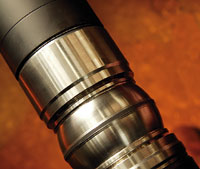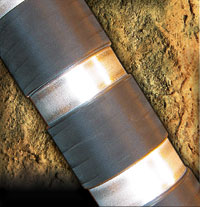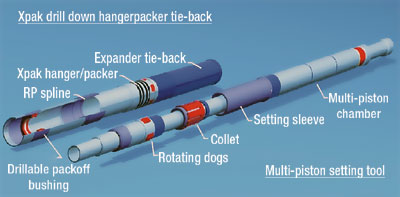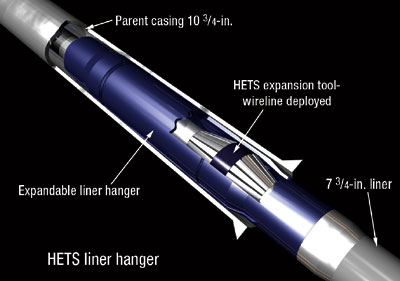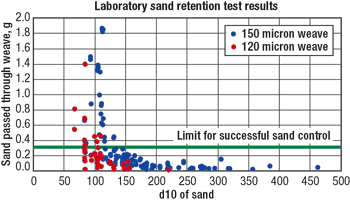Suppliers show progress in expandables innovation
Operators are embracing the latest developments and uses for expandables.
Oil Country Tubular GoodsSuppliers show progress in expandables innovationEight new developments and uses from five major service suppliers show that this technology continues strong uptake among operators.Perry A. Fischer, Editor; and Victor A. Schmidt, Drilling Engineering Editor This is our fourth consecutive year of our popular annual expandable round up.; previous issues of World Oil’s July issue should be referenced for a complete lineup, which is also available online. This year, eight new products or new applications for existing products are featured. First, there is an HP/ HT sealing device that uses an expanding metal-to-metal seal that contains no elastomers. There are two new expandable-liner hanger/ packer systems. One can be run as a conventional liner system; the other is a system that uses a tie-back expander working in conjunction with a hanger body, which together form an HP/ HT seal. And, there is one open-hole drilling liner that preserves drilling ID through unstable zones. Next comes a compelling case that says expandable tubulars can be used in H2S environments. Sixth, a metal-to-metal electro-hydraulic expansion system that can be deployed on monocable wireline. Ready for field testing is an expandable liner hanger for slim-well construction, which will be deployed as part of a drilling with casing system. Lastly, a new expandable screen weave opens expandable use for very fine-grained formations. BAKER OIL TOOLS
High-integrity pressure seal. Z-Seal*is a proprietary, high-expansion sealing device that uses expanding metal in place of elastomers to form a high-integrity pressure seal on the tubular wall, Fig. 1. The metal seal is insensitive to temperature failure modes and can withstand high pressure forces. Because it contains no elastomers, it improves downhole equipment performance in many well intervention applications, making intervention possible in hostile well environments that were previously deemed inoperable. The design uses controlled load and pressure to expand the metal seal up to 160% of its original size while maintaining HPHT performance. Applied differential pressure exerts additional self-energizing load to reinforce the seal. Because it does not rely on the memory of the metal, the expandable seal can be fully and actively retracted in applications that require tool retrieval. Eliminating elastomers also improves downhole equipment performance by eliminating conventional failure modes, such as explosive decompression, gasification, temperature and chemical degradation, shearing across the extrusion gap, dynamic fatigue and compressive load catastrophic fatigue. It also has a low profile that can be run in an increased range of smaller ODs and larger IDs.
The seal incorporates a compliant metal sealing surface that conforms to the bore with no extrusion gap, regardless if the surface is oval, pitted, grooved or otherwise malformed. Initial applications of the new seal with bridge plugs and straddle assemblies have been successful. Other uses are as a medium- to high-expansion solution for service packers and accessory tools. Liner hanger packer system. Later this year, BOT will introduce FORMlock TORXS*, the industry’s first expandable liner hanger packer system that can be run as a conventional liner system, Fig. 2. The system will be based on the same proprietary, elastomer-and-metal sealing element that is at the heart of the original FORMlock expandable liner packer system. Presently, expandable liner hangers and packers can be run and expanded downhole, but the running tools are not released until the well is cemented, which poses a problem risk. With the new system, the operator can run in the well and rotate as necessary, expand the anchoring system to hang the liner, release the running tool, cement the liner in place with circulation around the anchoring device, and expand the element for isolation, all in one trip. The system will be compatible with drill-in liner applications, because it can be circulated and rotated for reaming or drill-down operations. Instead of requiring a plug bump, applied pressure actuates the hydraulic anchor and swage mechanism on the running tool, causing the hanger body and anchor to expand and make permanent contact with the casing string. After cementing, applied pressure causes the swage to expand the sealing element to full permanent contact with the casing ID. After the packer is set, pressure is increased sufficiently to blow the rupture disk and allow the run-in string to be pulled from the liner top. A liner top test can be performed prior to coming out of hole. The company’s existing EXPress expandable screen set a Mexican record flowrate for Pemex. Expanded in 5-in. tubing, the Arquimia Well 41, in southeast Mexico’s Veracruz Asset, produced 87 MMcfd at its maximum potential from a near-horizontal (87°), 350-m section, with no sand production. Open-hole drilling liner. The EXdrill* system is an open-hole, stand-alone, non-cemented well support mechanism that is not connected back to the intermediate casing string and does not provide zonal isolation for production purposes, Fig 3. The tool temporarily isolates a problem zone, such as borehole instability or a lost circulation zone, so that drilling can continue. The system is deployed and expanded into an underreamed section of a wellbore on one trip. Once placed and expanded, it isolates the problem zone without reducing the drilling ID. Multiple systems can be deployed, if required. The new open-hole drilling liner is scheduled for release in late 2006. TIW HPHT liner hanger/ packer system. Expandable tubular technology has proved to be effective for liner hangers as well as casing repairs. Initially, TIW was looking for expandable technology that would give operators the hanging capability for both short and long liner applications, along with a HPHT seal at the liner top. TIW design engineers and operational personnel designed and tested a new concept called the X-Pak ELH System*, an expandable liner hanger/ packer system, Fig. 4. This system uses a tie-back expander working in conjunction with the hanger body; when set, they form an HPHT seal. The system is designed for high liner top pressure and temperature ratings, as well as increased hanger load. Tests show that the pressure integrity of the system is equal to that of the liner run or the casing in which it is set, whichever is weaker.
The system operates by using a hydraulic setting tool that presses the tie-back expander into the hanger body. Once hydraulically forced into the hanger body, the expander remains in place, forming a metal-to-metal seal between the two members. The unique action expands the hanger body against the base casing, providing the HPHT seal between the expander, hanger body, and base casing. The system also incorporates a tie-back receptacle that can be used for future tie-backs. There are two ways of setting this tool. The primary way is by the cementing process and “pump until you bump” technology. Once the liner wiper plug lands (bumps) on the landing collar, pressure is applied against the plug, increasing the pressure inside the casing and drill pipe until the system activation pressure is reached. With plugs bumped and cement in place, pressure in the drill pipe activates a shear ring on top of the hydraulic setting tool, allowing the power sections to extend, forcing the expander into the hanger body. The next step is to release from the liner by activating the Auto Release Mechanism. Once the hanger is set, simply slacking-off the liner weight, plus about 24 in. of drill pipe, causes the setting tool to automatically release from the liner; rotation is not required. A straight pickup then removes the drill pipe and setting tool from the liner. The secondary method of setting the system is accomplished by dropping a ball and letting it settle into a seat inside the setting tool. This method would only be used, when, or if, the liner wiper plug does not bump. Rotational release is also available, if needed. The drill pipe is rotated 22 torque-free turns to the right, which unscrews the setting tool from the hanger body and releases the liner. Once this occurs, the drill pipe and setting tool are pulled out of the hole. As an added feature, the system can be drilled-in or reamed into position, which makes it suited for liner drilling applications. Torque capabilities range from 32,000 ft/lb for 3½-in. OD drill pipe, to 48,475 ft/lb for 4½-in. OD and 5-in. OD drill pipe. To date, TIW has performed 10 successful installations. Sizes range from 4½-in. OD liners inside of 7-in. OD casing, to 7¾-in. OD liners inside of 10¾-in. OD casing. Liner lengths ranged from a minimum of about 2,500 ft to a maximum of approximately 6,250 ft, with the heaviest installation being 288,125-lb air weight. Depending on the size, operator requirements and/or limitations, liner tops have been pressure tested from 1,500 psi to 4,000 psi. Sizes can be manufactured to meet a multitude of customer requirements. As a rule of thumb, if you can run a liner inside the casing, a system can be manufactured to satisfy the hanging and pressure requirements. Sizes manufactured to date range from 3½-in. OD to set inside of 4½-in. OD up to 26-in. OD to set inside of 30-in. OD casing. Looking to the future, the company views the combinations of casing drilling, expandable liner tops, and monobore well designs as the most viable and economical means of reaching TDs that are inevitably getting deeper, more complex and, thus, more expensive to complete. These tools are the pioneers for this new technology, which will one day be commonplace in the oilfield. EVENTURE Expandable pipe for H2S. Eventure’s well established Cased-Hole Liner For example, offshore Africa, Marathon was able to isolate four different H2S-laced payzones and a leaking multi-stage cement tool using a hydraulic workover unit and an expanded cased-hole liner. The Tchatamba South B2-ST well offshore Gabon was converted from a shallow completion in the sour Azile formation, to a deep, sweet Madiela reservoir producer, optimizing field production and increasing overall recovery. Marathon installed 1,400 ft of 7-5/8-in. x 9-5/8-in. CHL to isolate the sour oil zone. After expanding the first anchor hanger and conducting an overpull test of 50 klb, a combination of hydraulic pressure (2,000 to 2,500 psi) and mechanical overpull (30 to 50 klb) was used to expand the rest of the liner. After expansion, the CHL was pressure tested to 2,000 psi, confirming successful isolation of the Azile perforations. After expansion, the expanded liner was pressure tested to 2,000 psi, confirming shutoff of the Azile perforations, as well as the leaking cement tool. The job is now two-years old and still holding. Marathon avoided the loss a year’s revenue waiting for a jackup drilling rig and realized $1.5 million in savings by using a local – and the only available – rig. READ WELL SERVICES This year will see two major developments in this company’s Hydraulically Expanded Tubular System (HETS) with the launch of a wireline deployment system and the introduction of a new liner-hanger product that will soon undergo field trials. Electro-hydraulic wireline module. Presently, HETS is deployed and expanded on drill pipe or coiled tubing. The Electro Hydraulic Wireline Module deploys the Expansion Tool on monocable wireline. The module uses surface read-out telemetry communication with a downhole motor, pump and intensifier arrangement, for real-time expansion process control. It also delivers up to 30,000 psi of high-pressure water required for the expansion process. The water is supplied from a reservoir section of the downhole tool. The module includes hardware to monitor the downhole expansion operation and a GR/ CCL unit for depth correlation. Wireline deployment substantially reduces operational cost and opens the door to subsea rigless intervention for the company’s expandable products. Expandable liner hanger. The company will be field testing a 7¾-in. x 10¾-in. liner hanger for slim-well construction, which will be deployed as part of a drilling with casing system later in 2006. The HETS-LH* liner hanger (Fig. 5) development has been designed to take the full axial and rotational load and pressure of the drilling operation. It is rated to withstand 45,000 ft-lb torque and 4,200 psi during the drilling phase. The hanger is run as part of the casing string during the drilling operation. Once the casing is on depth, it is cemented into place and then the hanger is expanded by running the HETS expansion tool on drill pipe or wireline.
Test qualification of the hanger is based on the ISO 14310 Packer Standard. In the most severe V0 test, the hanger was subjected to 5,500-psi gas pressure, both internally and externally, under 200-t, bi-directional loading at 15°C and 115°C. The test requires the hanger to retain integrity without allowing even a bubble of gas to pass its seals, Table 1. The new liner hanger performance benefits from its simplicity. With no moving parts, it does not require torque or rotation to set. During the field deployment, about 7,000 ft of hole will be drilled with casing. The new liner hanger can carry significant loads in both tension and compression because of the metal-to-metal contact force between the hanger and casing. The large residual interfacial pressure between the mating surfaces of the hanger and casing delivers high load-bearing capability. An additional benefit is that multiple hangers can be run in the same string. WEATHERFORD To meet the demands in more challenging reservoirs Weatherford has developed a new 120 µm weave, which extends the technology’s application envelop. In the past, three weave sizes were available (150, 230 and 270 µm). These sizes covered most applications; however, there remained some applications where the finest weave (150 µm) was unsuitable. In these applications, the only compliant alternative was to use a gravel pack with a small gravel size. This can be technically challenging, particularly with the requirement for efficient filter cake flow back to ensure good productivity. The 120 µm weave has undergone extensive testing to define its application envelop and to ensure it can be deployed in a wide range of drilling and completion fluids. The graph shows how it retains finer sands, Fig. 6. The new weave provides sand control solutions for isolating formations, giving cased hole functionality in open hole completions.
For improved zonal isolation, the company has developed the 7-in. ESS/ EZI (Expandable Zonal Isolation)* combination, an enhanced system for 8½-in. open holes. In addition, deployment methods for the ESS systems (5½-in. and 4½-in.) have been adapted for a wide range of openhole zonal isolation products. These systems, using the 120 µm weave, have already been run in applications worldwide. Weatherford has supplied over 250,000 ft of Expandable Sand Screens (ESS) in 400 installations with a total production history of over 1,000 years. ESS has been used in a wide variety of applications across all regions. Click here for a complete list of World Oil’s annual expandable technology reports.
|
||||||||||||||||||||||||||||
- Coiled tubing drilling’s role in the energy transition (March 2024)
- Using data to create new completion efficiencies (February 2024)
- Digital tool kit enhances real-time decision-making to improve drilling efficiency and performance (February 2024)
- E&P outside the U.S. maintains a disciplined pace (February 2024)
- U.S. operators reduce activity as crude prices plunge (February 2024)
- Drilling advances (January 2024)

